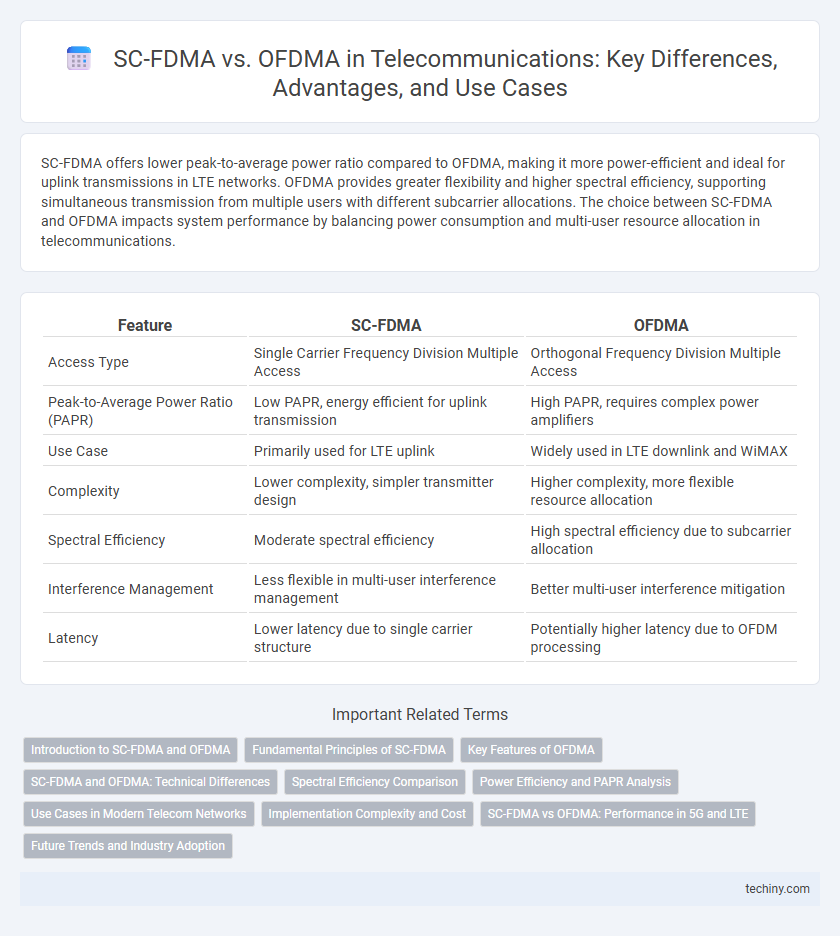SC-FDMA offers lower peak-to-average power ratio compared to OFDMA, making it more power-efficient and ideal for uplink transmissions in LTE networks. OFDMA provides greater flexibility and higher spectral efficiency, supporting simultaneous transmission from multiple users with different subcarrier allocations. The choice between SC-FDMA and OFDMA impacts system performance by balancing power consumption and multi-user resource allocation in telecommunications.
Table of Comparison
| Feature | SC-FDMA | OFDMA |
|---|---|---|
| Access Type | Single Carrier Frequency Division Multiple Access | Orthogonal Frequency Division Multiple Access |
| Peak-to-Average Power Ratio (PAPR) | Low PAPR, energy efficient for uplink transmission | High PAPR, requires complex power amplifiers |
| Use Case | Primarily used for LTE uplink | Widely used in LTE downlink and WiMAX |
| Complexity | Lower complexity, simpler transmitter design | Higher complexity, more flexible resource allocation |
| Spectral Efficiency | Moderate spectral efficiency | High spectral efficiency due to subcarrier allocation |
| Interference Management | Less flexible in multi-user interference management | Better multi-user interference mitigation |
| Latency | Lower latency due to single carrier structure | Potentially higher latency due to OFDM processing |
Introduction to SC-FDMA and OFDMA
SC-FDMA (Single Carrier Frequency Division Multiple Access) and OFDMA (Orthogonal Frequency Division Multiple Access) are key multiple access schemes in modern telecommunications, especially in LTE and 5G networks. SC-FDMA employs a single carrier modulation with frequency domain spreading, offering lower Peak-to-Average Power Ratio (PAPR) and improved power efficiency in uplink transmissions. OFDMA divides the spectrum into orthogonal subcarriers, enabling flexible resource allocation and high spectral efficiency mainly used in downlink scenarios.
Fundamental Principles of SC-FDMA
SC-FDMA (Single Carrier Frequency Division Multiple Access) utilizes a single-carrier modulation scheme combined with frequency domain equalization to reduce the peak-to-average power ratio (PAPR) compared to OFDMA (Orthogonal Frequency Division Multiple Access). Its fundamental principle involves mapping user data symbols through a discrete Fourier transform (DFT) before subcarrier mapping, which ensures single-carrier transmission characteristics and efficiency in uplink communication. This low PAPR property makes SC-FDMA highly suitable for uplink channels in LTE, improving power efficiency in mobile devices.
Key Features of OFDMA
OFDMA (Orthogonal Frequency Division Multiple Access) divides the spectrum into multiple orthogonal subcarriers, enabling simultaneous data transmission from multiple users with high spectral efficiency. It supports flexible resource allocation and adaptive modulation, optimizing throughput and reducing latency in diverse network conditions. OFDMA's robustness against frequency-selective fading and inter-symbol interference enhances its performance in high-mobility environments common in 4G and 5G wireless communication systems.
SC-FDMA and OFDMA: Technical Differences
SC-FDMA employs single-carrier transmission, reducing peak-to-average power ratio (PAPR) compared to OFDMA, which uses multi-carrier orthogonal frequency division multiplexing leading to higher PAPR. SC-FDMA's lower PAPR allows for more efficient power amplification in mobile devices, making it suitable for uplink transmissions in LTE networks. OFDMA offers flexible subcarrier allocation and better robustness to multipath fading, making it ideal for downlink communication with higher spectral efficiency.
Spectral Efficiency Comparison
SC-FDMA offers higher spectral efficiency in uplink LTE transmissions due to its lower peak-to-average power ratio, reducing power amplifier back-off and improving energy utilization. OFDMA, widely used in downlink scenarios, enables flexible resource allocation and better multi-user interference management but suffers from higher signal distortion and spectral regrowth. The spectral efficiency of SC-FDMA is thus optimized for user equipment power constraints, whereas OFDMA maximizes throughput and capacity in base station transmissions.
Power Efficiency and PAPR Analysis
SC-FDMA offers significantly lower Peak-to-Average Power Ratio (PAPR) compared to OFDMA, resulting in enhanced power efficiency and reduced power amplifier back-off requirements. This characteristic makes SC-FDMA highly suitable for uplink transmissions in LTE systems, where battery life and terminal power consumption are critical factors. The lower PAPR of SC-FDMA minimizes signal distortion and improves overall transmitter efficiency, contributing to prolonged device operation and better spectral efficiency.
Use Cases in Modern Telecom Networks
SC-FDMA is primarily utilized in the uplink of LTE networks due to its low peak-to-average power ratio (PAPR), enhancing battery efficiency for mobile devices. OFDMA dominates downlink transmissions in 4G and 5G networks, enabling high spectral efficiency and flexible resource allocation for diverse services. Emerging 5G use cases leverage OFDMA for massive data throughput, while SC-FDMA remains critical for uplink scenarios requiring energy-efficient user equipment.
Implementation Complexity and Cost
SC-FDMA offers lower implementation complexity and reduced cost compared to OFDMA due to its simpler single-carrier modulation and lower peak-to-average power ratio (PAPR). OFDMA requires more complex signal processing and power amplifier designs, increasing hardware complexity and overall system expenses. This makes SC-FDMA particularly advantageous for uplink transmission in cellular networks where cost efficiency and power efficiency are critical.
SC-FDMA vs OFDMA: Performance in 5G and LTE
SC-FDMA offers lower peak-to-average power ratio (PAPR) compared to OFDMA, making it more power-efficient and ideal for uplink transmission in LTE and 5G networks. OFDMA supports higher spectral efficiency and better frequency selectivity, enhancing downlink performance and accommodating diverse user demands. The choice between SC-FDMA and OFDMA impacts system capacity, battery life, and overall network performance in 5G and LTE deployments.
Future Trends and Industry Adoption
SC-FDMA offers lower peak-to-average power ratio (PAPR), making it highly suitable for uplink transmissions in 5G networks, while OFDMA dominates downlink channels due to its superior spectral efficiency and flexibility. Future trends indicate continued hybrid integration of SC-FDMA and OFDMA to optimize power consumption and data throughput in evolving 6G architectures. Industry adoption is accelerating toward adaptive modulation schemes that dynamically switch between SC-FDMA and OFDMA based on real-time network conditions and user demands.
SC-FDMA vs OFDMA Infographic

 techiny.com
techiny.com